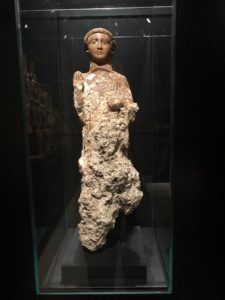MALAKA HALL
In 1,958, in front of the city of Tyre in present-day Lebanon, a shipwreck was discovered by chance when it found itself entangled on a fishermen’s net. When the fishermen pulled their net, they found a terracotta figurine incrusted with mollusks and shells.
With the financing of the galleries that operated in Lebanon during those years and of a first cleaning, intervention and identification of the pieces, these were acquired for the most part by the galleries existing in that area. During the subsequent years, the individual pieces were distributed through different galleries and private collections around the world.
The collector Vicente Jimenez Ifergan has dedicated many years of research towards the recovery of the majority of the pieces originating from this shipwreck. Nowadays, they gather inside the Malaka Hall and constitute the most important Phoenician terracotta figures (from the 6th – 4th century B.C) originating from the Temple of the city of Tyre in present-day Lebanon.
There are more than 100 spectacular votive figures of men and women who really existed and unite the visitor with the Phoenician origin of the city of Malaga through Ayin, one of the sculptures in the Malaka Hall. This sculpture represents the protagonist child who narrates the incredible story of the pieces originating from this shipwreck. Nowadays, they reunite inside the Malaka Hall and constitute the most important Phoenician terracotta figures collection (6th – 4th century B.C.) originating from the Temple in the city of Tyro in present-day Lebanon.
